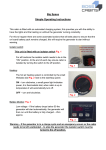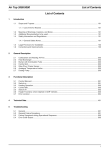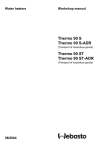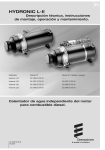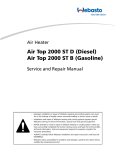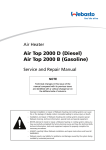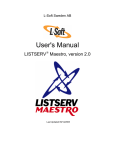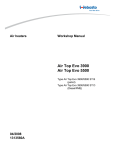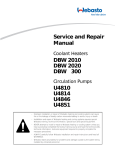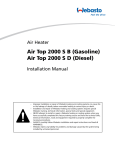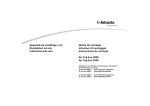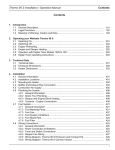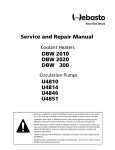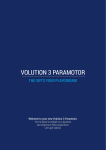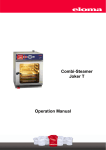Download Thermo 90 Thermo 90 S
Transcript
Coolant Heater Thermo 90 Thermo 90 S Workshop Manual Webasto Thermosystems Inc. North America 3333 John Conley Drive Lapeer, MI 48446 Phone (810) 245-2400 Toll-free (800) HEATER-1 Fax (810) 664-7720 Technical Assistance Hotline USA: (800) 555-4518 Canada: (800) 667-8900 Rev. 03/2000 907400 www.webasto.com THERMO 90 / 90 S TABLE OF CONTENTS Table of Contents 1. Introduction 1.1 Scope and Purpose . . . . . . . . . . . . . . . . . . . . . . . . . . . . . . . . . . . . . . . . . . . . . . . . . . . . 1.2 Meaning of Warnings, Cautions and Notes . . . . . . . . . . . . . . . . . . . . . . . . . . . . . . . . . . 1.3 Additional Documentation to be used . . . . . . . . . . . . . . . . . . . . . . . . . . . . . . . . . . . . . . . 1.4 General Safety Regulations and Information . . . . . . . . . . . . . . . . . . . . . . . . . . . . . . . . . 1.4.1 1.5 2. 3. 1-1 1-1 1-1 1-1 General Safety Notes . . . . . . . . . . . . . . . . . . . . . . . . . . . . . . . . . . . . . . . . . . . 1-1 Corrections and Improvements . . . . . . . . . . . . . . . . . . . . . . . . . . . . . . . . . . . . . . . . . . . 1-2 General Description 2.1 Combustion Air Fan . 2.2 Heat Exchanger . . . 2.3 Temperature Sensor 2.4 Temperature Limiter . 2.5 Burner Insert . . . . . . 2.6 Glow Pin . . . . . . . . . 2.7 Flame Sensor . . . . . 2.8 Combustion Tube . . 2.9 Circulation Pump . . . 2.10 Control Unit . . . . . . . 2.11 Fuel Dosing Pump . . . . . . . . . . . . . . . . . . . . . . . . . . . . . . . . . . . . . . . . . . . . . . . . . . . . . . . . . . . . . . . . . . . . . . . . . . . . . . . . . . . . . . . . . . . . . . . . . . . . . . . . . . . . . . . . . . . . . . . . . . . . . . . . . . . . . . . . . . . . . . . . . . . . . . . . . . . . . . . . . . . . . . . . . . . . . . . . . . . . . . . . . . . . . . . . . . . . . . . . . . . . . . . . . . . . . . . . . . . . . . . . . . . . . . . . . . . . . . . . . . . . . . . . . . . . . . . . . . . . . . . . . . . . . . . . . . . . . . . . . . . . . . . . . . . . . . . . . . . . . . . . . . . . . . . . . . . . . . . . . . . . . . . . . . . . . . . . . . . . . . . . . . . . . . . . . . . . . . . . . . . . . . . . . . . . . . . . . . . . . . . . . . . . . . . . . . . . . . . . . . . . . . . . . . . . . . . . . . . . . . . . . . . . . . . . . . . . . . . . . . . . . . . . . . . . . . . . . . . . . . . . . . . . . . . . . . . . . . . . . . . . . . .... .... .... .... .... .... .... .... .... .... .... 2-2 2-2 2-3 2-3 2-3 2-3 2-3 2-3 2-3 2-3 2-3 Functional Description (Fig.3-1) 3.1 Switch-on . . . . . . . . . . . . 3.2 Heating Operation . . . . . . 3.3 Control Operation . . . . . . 3.4 Switch-off . . . . . . . . . . . . 3.5 Malfunctions . . . . . . . . . . . . . . . . . . . . . . . . . . . . . . . . . . . . . . . . . . . . . . . . . . . . . . . . . . . . . . . . . . . . . . . . . . . . . . . . . . . . . . . . . . . . . . . . . . . . . . . . . . . . . . . . . . . . . . . . . . . . . . . . . . . . . . . . . . . . . . . . . . . . . . . . . . . . . . . . . . . . . . . . . . . . . . . . . . . . . . . . . . . . . . . . . . . . . . . . . . . . . . . . . . . . . . . . . . . . . . . . . . . . . . ... ... ... ... ... 3-1 3-1 3-1 3-1 3-3 Switch-off upon Failure . . . . . . . . . . . . . . . . . . . . . . . . . . . . . . . . . . . . . . . . . . Diagnosis after Switch-off upon Failure (Thermo 90) . . . . . . . . . . . . . . . . . . . . Diagnosis after Switch-off upon Failure (Thermo 90 S) . . . . . . . . . . . . . . . . . . . Reading and Understanding the Flash Code . . . . . . . . . . . . . . . . . . . . . . . . . . 3-3 3-3 3-3 3-3 3.5.1 3.5.2 3.5.3 3.5.4 . . . . . . . . . . . . . . . . . . . . . . . . . . . . . . . . . 4. 4. Technical Data (Standard Measure) . . . . . . . . . . . . . . . . . . . . . . . . . . . . . . . . . . . . . . . . . . . . 4-1 Technical Data (Metric Measure) . . . . . . . . . . . . . . . . . . . . . . . . . . . . . . . . . . . . . . . . . . . . . . 4-2 5. Troubleshooting 5.1 General . . . . . . . . . . . . . . . . . . . . . . . . . . . . . . . . . . . . . . . . . . . . . . . . . . . . . . . . . . . . . 5.2 General Failure Symptoms . . . . . . . . . . . . . . . . . . . . . . . . . . . . . . . . . . . . . . . . . . . . . . 5.3 Failure Symptoms after Switch-off upon Failure . . . . . . . . . . . . . . . . . . . . . . . . . . . . . . . 5.4 Storing a Fault Code in Memory . . . . . . . . . . . . . . . . . . . . . . . . . . . . . . . . . . . . . . . . . . 5-1 5-1 5-2 5-3 I TABLE OF 5.4.1 5.5 Reading and Removing Error Codes Stored in Memory using the PC Diagnostics Kit P.N. 92542C . . . . . . . . . . . . . . . . . . . . . . . . . . . . . . . . . . . 5-3 Visual Inspection for Assessment of Burner Condition . . . . . . . . . . . . . . . . . . . . . . . . . . 5-4 5.5.1 5.5.2 5.5.3 5.5.4 6. THERMO 90 / 90 S CONTENTS Burner Housing . . . . . . . . . . . . . Rear Wall with Metal Evaporator Combustion Chamber . . . . . . . . Burner Assembly . . . . . . . . . . . . . . . . . . . . . . . . . . . . . . . . . . . . . . . . . . . . . . . . . . . . . . . . . . . . . . . . . . . . . . . . . . . . . . . . . . . . . . . . . . . . . . . . . . . . . . . . . . . . . . . . . . . . . . . . . . . . . . . . . . . . . . . . . . . . . . . . . . . . . . . . 5-4 5-5 5-5 5-5 Functional Tests 6.1 General . . . . . . . . . . . . . . . . . . . . . . . . . . . . . . . . . . . . . . . . . . . . . . . . . . . . . . . . . . . . . 6-1 6.2 Adjustments . . . . . . . . . . . . . . . . . . . . . . . . . . . . . . . . . . . . . . . . . . . . . . . . . . . . . . . . . 6-1 6.2.1 6.3 Adjustment of the CO2 Content . . . . . . . . . . . . . . . . . . . . . . . . . . . . . . . . . . . . 6-1 Components Testing . . . . . . . . . . . . . . . . . . . . . . . . . . . . . . . . . . . . . . . . . . . . . . . . . . . 6-1 6.3.1 6.3.2 6.3.3 6.3.4 Temperature Sensor Resistance Check . . . . . . . . . . . . . . . . . . . . . . . . . . . . . . Glow Pin Resistance Check . . . . . . . . . . . . . . . . . . . . . . . . . . . . . . . . . . . . . . . Flame Sensor Resistance Test . . . . . . . . . . . . . . . . . . . . . . . . . . . . . . . . . . . . Combustion Air Fan Test . . . . . . . . . . . . . . . . . . . . . . . . . . . . . . . . . . . . . . . . . 6-1 6-1 6-1 6-1 7. Circuit Diagrams 7.1 General . . . . . . . . . . . . . . . . . . . . . . . . . . . . . . . . . . . . . . . . . . . . . . . . . . . . . . . . . . . . . 7-1 8. Servicing 8.1 General . . . . . . . . . . . . . . . . . . . . . . . . . . . . . . . . . . . . . . . . . . . . . . . . . . . . . . . . . . . . . 8.2 Work on the Heater . . . . . . . . . . . . . . . . . . . . . . . . . . . . . . . . . . . . . . . . . . . . . . . . . . . . 8.3 Work on the Vehicle . . . . . . . . . . . . . . . . . . . . . . . . . . . . . . . . . . . . . . . . . . . . . . . . . . . 8.4 Heater Test Run . . . . . . . . . . . . . . . . . . . . . . . . . . . . . . . . . . . . . . . . . . . . . . . . . . . . . . 8.5 Annual Maintenance . . . . . . . . . . . . . . . . . . . . . . . . . . . . . . . . . . . . . . . . . . . . . . . . . . . 8.6 Visual Inspections and Installation Regulations . . . . . . . . . . . . . . . . . . . . . . . . . . . . . . . 8.6.1 8.6.2 8.6.2.1 8.6.2.2 8.6.3 8.6.3.1 8.6.3.2 8.6.4 8.6.5 8.6.6 8.7 8-3 8-3 8-4 8-5 8-5 8-5 8-6 8-6 8-6 8-6 Removal and Installation . . . . . . . . . . . . . . . . . . . . . . . . . . . . . . . . . . . . . . . . . . . . . . . . 8-7 8.7.1 8.7.1.1 II Connection to the Vehicle’s Cooling System . . . . . . . . . . . . . . . . . . . . . . . . . . Connection to the Vehicle’s Fuel System . . . . . . . . . . . . . . . . . . . . . . . . . . . . . Fuel Tapping . . . . . . . . . . . . . . . . . . . . . . . . . . . . . . . . . . . . . . . . . . . . . . . . . . Fuel Lines . . . . . . . . . . . . . . . . . . . . . . . . . . . . . . . . . . . . . . . . . . . . . . . . . . . . Fuel Dosing Pump . . . . . . . . . . . . . . . . . . . . . . . . . . . . . . . . . . . . . . . . . . . . . . Installation Location . . . . . . . . . . . . . . . . . . . . . . . . . . . . . . . . . . . . . . . . . . . . . Installation and Attachment . . . . . . . . . . . . . . . . . . . . . . . . . . . . . . . . . . . . . . . Fuel Filter . . . . . . . . . . . . . . . . . . . . . . . . . . . . . . . . . . . . . . . . . . . . . . . . . . . . Combustion Air Supply . . . . . . . . . . . . . . . . . . . . . . . . . . . . . . . . . . . . . . . . . . Exhaust Line . . . . . . . . . . . . . . . . . . . . . . . . . . . . . . . . . . . . . . . . . . . . . . . . . . 8-1 8-1 8-1 8-1 8-1 8-3 Heater, Removal and Installation . . . . . . . . . . . . . . . . . . . . . . . . . . . . . . . . . . . 8-7 Removal . . . . . . . . . . . . . . . . . . . . . . . . . . . . . . . . . . . . . . . . . . . . . . . . . . . . . 8-7 THERMO 90 / 90 S 8.7.1.2 8.7.2 8.7.3 8.7.4 8.7.5 8.8 9. TABLE OF CONTENTS Installation . . . . . . . . . . . . . . . . . . . . . . . . . . . . . . . . . . . . . . . . . . . . . . . . . . . . Replacement of Circulation Pump . . . . . . . . . . . . . . . . . . . . . . . . . . . . . . . . . . Replacement of Temperature Limiter . . . . . . . . . . . . . . . . . . . . . . . . . . . . . . . . Replacement of Temperature Sensor . . . . . . . . . . . . . . . . . . . . . . . . . . . . . . . . Replacement of Combustion Air Fan . . . . . . . . . . . . . . . . . . . . . . . . . . . . . . . . 8-7 8-7 8-7 8-7 8-7 First Operation . . . . . . . . . . . . . . . . . . . . . . . . . . . . . . . . . . . . . . . . . . . . . . . . . . . . . . . 8-7 Repair 9.1 General . . . . . . . . . . . . . . . . . . . . . . . . . . . . . . . . . . . . . . . . . . . . . . . . . . . . . . . . . . . . . 9-1 9.1.1 9.1.1.1 9.1.1.2 9.2 Work on Components after Disassembly . . . . . . . . . . . . . . . . . . . . . . . . . . . . . 9-1 Cleaning . . . . . . . . . . . . . . . . . . . . . . . . . . . . . . . . . . . . . . . . . . . . . . . . . . . . . 9-1 Visual Inspection . . . . . . . . . . . . . . . . . . . . . . . . . . . . . . . . . . . . . . . . . . . . . . . 9-1 Disassembly and Assembly . . . . . . . . . . . . . . . . . . . . . . . . . . . . . . . . . . . . . . . . . . . . . . 9-2 9.2.1 9.2.1.1 9.2.1.2 9.2.2 9.2.2.1 9.2.2.2 9.2.3 9.2.3.1 9.2.3.2 9.2.4 9.2.4.1 9.2.4.2 9.2.5 9.2.5.1 9.2.5.2 9.2.6 9.2.6.1 9.2.6.2 9.2.7 9.2.7.1 9.2.7.2 9.2.8 9.2.8.1 9.2.8.2 Electrical Connections (Fig. 9-1) . . . . . . . . . . . . . . . . . . . . . . . . . . . . . . . . . . . 9-2 Disconnecting Electrical Connections (Connection X1) . . . . . . . . . . . . . . . . . . . 9-2 Making Electrical Connections . . . . . . . . . . . . . . . . . . . . . . . . . . . . . . . . . . . . . 9-2 Replacement of Circulation Pump . . . . . . . . . . . . . . . . . . . . . . . . . . . . . . . . . . 9-3 Removal . . . . . . . . . . . . . . . . . . . . . . . . . . . . . . . . . . . . . . . . . . . . . . . . . . . . . 9-3 Installation . . . . . . . . . . . . . . . . . . . . . . . . . . . . . . . . . . . . . . . . . . . . . . . . . . . . 9-3 Replacement of Temperature Limiter . . . . . . . . . . . . . . . . . . . . . . . . . . . . . . . . 9-4 Removal . . . . . . . . . . . . . . . . . . . . . . . . . . . . . . . . . . . . . . . . . . . . . . . . . . . . . 9-4 Installation . . . . . . . . . . . . . . . . . . . . . . . . . . . . . . . . . . . . . . . . . . . . . . . . . . . . 9-4 Replacement of Temperature Sensor . . . . . . . . . . . . . . . . . . . . . . . . . . . . . . . . 9-4 Removal . . . . . . . . . . . . . . . . . . . . . . . . . . . . . . . . . . . . . . . . . . . . . . . . . . . . . 9-4 Installation . . . . . . . . . . . . . . . . . . . . . . . . . . . . . . . . . . . . . . . . . . . . . . . . . . . . 9-4 Replacement of Combustion Air Fan . . . . . . . . . . . . . . . . . . . . . . . . . . . . . . . . 9-6 Removal . . . . . . . . . . . . . . . . . . . . . . . . . . . . . . . . . . . . . . . . . . . . . . . . . . . . . 9-6 Installation . . . . . . . . . . . . . . . . . . . . . . . . . . . . . . . . . . . . . . . . . . . . . . . . . . . . 9-6 Replacement of Burner, Flame Sensor and Glow Pin . . . . . . . . . . . . . . . . . . . . 9-7 Removal . . . . . . . . . . . . . . . . . . . . . . . . . . . . . . . . . . . . . . . . . . . . . . . . . . . . . 9-7 Installation . . . . . . . . . . . . . . . . . . . . . . . . . . . . . . . . . . . . . . . . . . . . . . . . . . . . 9-7 Replacement of Burner Head . . . . . . . . . . . . . . . . . . . . . . . . . . . . . . . . . . . . . 9-9 Removal . . . . . . . . . . . . . . . . . . . . . . . . . . . . . . . . . . . . . . . . . . . . . . . . . . . . . 9-9 Installation . . . . . . . . . . . . . . . . . . . . . . . . . . . . . . . . . . . . . . . . . . . . . . . . . . . . 9-9 Replacement of Heat Exchanger . . . . . . . . . . . . . . . . . . . . . . . . . . . . . . . . . . . 9-10 Removal . . . . . . . . . . . . . . . . . . . . . . . . . . . . . . . . . . . . . . . . . . . . . . . . . . . . . 9-10 Installation . . . . . . . . . . . . . . . . . . . . . . . . . . . . . . . . . . . . . . . . . . . . . . . . . . . . 9-10 III THERMO 90 / 90 S 1. Introduction 1.1 Scope and Purpose This repair shop manual is intended to support familiarized personnel in the repair of Thermo 90 and Thermo 90 S coolant heaters. The coolant heater may only be operated with the specified fuel (Diesel 1, Diesel 2, Arctic grade, Kerosene and certain military spec. fuels). The coolant heater may only be operated within the specified operating voltage range designated by type. 1.2 Meaning of Warnings, Cautions, and Notes Warnings, Cautions and Notes in this manual have the following meaning: WARNING This heading is used to highlight that non-compliance with instructions or procedures may cause injuries or lethal accidents to personnel. 1 1.4 INTRODUCTION General Safety Regulations and Information The general safety regulations for the prevention of accidents and relevant operating safety instructions must be observed at all times. The specific safety regulations applicable to this manual are highlighted in the individual chapters by Warnings, Cautions and Notes. 1.4.1 General Safety Notes The heater may only be installed in motor vehicles, or in independent heating systems, with a minimum coolant capacity of 6 litres (1.6 US Gal.). The heater must not be installed in the passenger compartments of vehicles. Should the heater be installed in such a compartment, the installation box must be sealed tight against the vehicle interior. There must be sufficient ventilation of the installation box from the exterior in order not to exceed a maximum temperature of 60 °C (140 °F) in the installation box. Excessive temperatures may cause malfunctions. CAUTION This heading is used to highlight that non-compliance with instructions or procedures may cause damage to equipment. WARNING Due to the danger of poisoning and suffocation, the heater must not be operated in enclosed areas, such as garages or workshops, without an exhaust venting system, not even if the start-up is activated by the timer or remote start device. NOTE: This heading is used to highlight and draw specific attention to information. At filling stations and fuel depots the heater must be switched off as there is a potential danger of explosions. 1.3 Where flammable fumes or dust may build up (e.g. in the vicinity of fuel, coal, wood, cereal grain deposits or similar situations) the heater must be switched off to prevent explosions. Additional Documentation to be Used This workshop manual contains all information and procedures necessary for the repair of heaters Thermo 90 and Thermo 90 S. The use of additional documentation is normally not necessary. Operating instructions/installation instructions and the vehicle specific installation guides (when available) may be used as complementary information if necessary. In the vicinity of the coolant heater, a temperature of 85 °C (185 °F) must not be exceeded under any circumstances (e.g. during body paint work). A violation of this temperature limit may cause permanent damage to the electronics. When checking the coolant level, proceed in accordance with the vehicle manufacturer’s instructions. The coolant in the heating circuit of the heater must contain a minimum of 10% of a quality brand glycol based anti-freeze. 1-1 1 THERMO 90 / 90 S INTRODUCTION Ignoring the installation instructions and its procedures will void the warranty granted by Webasto. The same applies for repairs preformed by unskilled, unauthorized personnel and repairs without using genuine Webasto spare parts. This will void the coolant heaters “Official Marks of Conformity.” This does not apply for towing vehicles with an open cockpit. Extracting combustion air from the vehicle interior is not permissible under any circumstance. The exhaust line outlet is to be positioned below the vehicle floor, to the nearest possible location of the vehicle’s or cockpit side or rear end. Exhaust pipes must be routed so that exhaust fumes will not penetrate into the vehicle’s interior. The function of any parts vital for vehicle operation must not be impaired. Condensation accumulation in the exhaust line must be directly drained. A condensation drain hole may be provided as required. Electrical lines, switch gear, and control gear of the heater must be located in the vehicle so that their proper function cannot be impaired under normal operating conditions. For the routing of fuel lines and the installation of additional fuel tanks, the following important regulations must be adhered to: • Fuel lines are to be installed in such a way that they remain unaffected by torsional stresses created by vehicle and engine movement. They must be protected against mechanical damage. Fuel-carrying parts are to be protected against excessive heat and are to be installed so that any dripping or evaporating fuel can neither accumulate nor be ignited by hot components or electrical equipment. • In busses, fuel lines and fuel tanks must not be located in the passenger area or in the driver’s compartment. In these type of vehicles the fuel tanks must be located such that they do not pose a direct hazard to the exits in the event of a fire. Fuel supply must not be by means of gravity or pressurization of the fuel tank. • Installation instructions for Webasto fuel tanks for the fuel supply of coolant heaters in vehicles: In busses the installation is not permitted in the passenger or driver’s compartment. • The fuel filler neck must not be located in the passengers or driver’s compartment of any vehicle. • Fuel containers for gasoline fuel must not be located immediately behind the front paneling of the vehicle. They must be separate from the engine so that even in the case of accident the inflammation of fuel is unlikely to be expected. 1-2 • • All fuel containers offered in the Webasto Accessories Catalog are suitable for a maximum operating pressure of 0.15 bar over-pressure. All fuel containers offered in the Webasto Accessories Catalog are subjected during manufacture to individual pressure testing with at least 0.3 bar over-pressure. The fuel containers must either be equipped with a vent cap or be ventilated in another way (ventilation line). Only filler caps in accordance with DIN 73400 may be used. The operational state of the heater, i.e. an indication “on” or “off”, must be clearly visible. THERMO 90 / 90 S 2. 2 GENERAL DESCRIPTION diesel operated coolant heaters for up to 2 hours after heater actuation. General Description The Webasto Thermo 90 and 90 S coolant heater, in combination with the vehicle’s own heating system, is used to: The Webasto Thermo 90 and 90 S coolant heaters basically consist of: • • • • • • • heat the cab, sleeper or interior areas of vehicles defog/defrost windshields preheat water cooled engines The coolant heater operates independent from the vehicle engine and is connected to the cooling system, the fuel system and the electrical system of the vehicle. The heater is designed around the Ferro-Tec Technology evaporator burner system and operates intermittently, controlled by the temperature sensor. Dependent on the deviation of the current coolant temperature from the rated value of the temperature sensor, combustion performance is continuously controlled within a range from 1.8 to 7.6 kW (6,100 to 26,000 Btu/hr) for Diesel operated heaters and within 2.0 to 7.6 kW (6,800 to 26,000 Btu/hr) for gasoline operated coolant heaters. For an extremely high heating performance requirement (preheating) the maximum performance of 9.1 kW (31,000 Btu/hr) is available with combustion air fan heat exchanger burner insert with combustion tube circulation pump For control and monitoring, the following are located inside the heater unit: • • • • • control unit (external) flame sensor glow pin temperature sensor temperature limiter On the Thermo 90 S heater, the control unit is flanged to the combustion air fan. It is possible to remote mount the control unit using an optional mounting bracket. NOTE: One of the newer models shown. Older models have the temperature sensor cable located on the side. Heater Thermo 90 1 2 3 4 5 6 7 8 9 10 Combustion Air Fan Fuel Connection Temperature Sensor Temperature Limiter Heat Exchanger Inlet, Coolant Circulation Pump Outlet, Coolant Outlet, Exhaust Inlet, Combustion Air 2-1 2 THERMO 90 / 90 S GENERAL DESCRIPTION 1 2 3 4 5 6 7 8 9 10 11 Heater Thermo 90 S 2.1 Combustion Air Fan The combustion air fan delivers the air required for combustion from the combustion air inlet to the burner insert. 2-2 2.2 Combustion Air Fan Fuel Connection Temperature Sensor Temperature Limiter Heat Exchanger Inlet, Coolant Circulation Pump Outlet, Coolant Outlet, Exhaust Inlet, Combustion Air Control unit (may also be located remotely in the vehicle) Heat Exchanger The heat exchanger transfers the heat provided by combustion to the coolant circuit. THERMO 90 / 90 S 2.3 Temperature Sensor The temperature sensor senses the coolant temperature in the heat exchanger of the heater unit as electrical resistance. This signal is fed to the control unit for processing. 2.4 2 2.8 GENERAL DESCRIPTION Combustion Tube Inside the combustion tube the combustion of the fuel/air mixture takes place, heating up the heat exchanger. Temperature Limiter The overheat protection (bimetal) protects the heater unit from excessive operating temperatures. The overheat protection responds at a coolant temperature higher than 105 °C to switch off the heater. 2.5 Burner Insert Within the burner insert, fuel is distributed in the combustion tube across the burner cross-section. 2.6 Glow Pin The glow pin ignites the fuel/air mixture at the start of heater operation. The glow pin is acting as an electrical resistor and is located in the burner insert opposite the flame source. 2.9 Circulation Pump The circulation pump provides for circulation of the coolant in the vehicle and heater circuits. The control unit switches the pump on for operation throughout the entire time of heater operation (also in control idle). 2.10 Control Unit The control unit is the central controlling device for functional sequencing and monitoring of the combustion operation. It is mounted to the heat exchanger on Thermo 90 heaters and flanged to the combustion air fan on Thermo 90 S heaters. 2.7 Flame Sensor The flame sensor is a low-Ohm PTC resistor, changing its resistance dependent on its heating by the flame. The signals are routed to the control unit for processing. The flame sensor monitors the flame operating condition over the complete duration of heater operation. 2.11 Fuel Dosing Pump Fuel supply to the heater and its dosing is ensured externally by a fuel dosing pump. When the heater is deactivated, it also serves as a shut-off valve. The magnetic coil of the dosing pump receives the pulses from the microprocessor of the control unit. 2-3 THERMO 90 / 90 S 3. 3.1 Functional Description (Fig. 3-1) Switch-on When operating the push button "Immediate Heating", the "Operating Indicator" on the timer illuminates 3 3.4 FUNCTIONAL DESCRIPTION Switch-off When switching the heater off, the operation indicator on the timer/switch extinguishes. Combustion ends and the run-down cycle is initiated. The circulation pump and combustion air fan, however, continue operation to cool down the heater (run-down) and are automatically deactivated after about 90 seconds. A reactivation of the heater during run-down is permitted. or by activation with the switch, the “Operating Indicator” integrated in the switch illuminates. Room temperature control by means of the vehicle's own heating blower may be provided in addition to employing a room thermostat. Circulation pump, glow pin, and combustion air fan are put into operation. 3.2 Heating Operation After approx. 50 seconds, combustion commences with the automatically controlled heating operation in full load for a maximum of 2 hours. The vehicle's own heating blower starts to operate only after the heat carrier (coolant) has accumulated enough heat. After reaching the pre-coded rated temperature (see table Control Temperatures) heating performance, precision control will take over in stages down to the lowest part load operation. 3.3 Control Operation If the coolant temperature rises up to the control idle threshold, the heater enters the control idle phase. The circulation pump, the vehicle's own blower, and the operating indicator remain in operation during the control idle period. After the coolant has cooled down to the pre-coded reactivation temperature, the heater resumes operation. Diesel Operated Coolant heaters If the coolant heater's coolant temperature is above the rated temperature but has not yet reached the threshold for control idle, with the temperature dropping within 10 minutes back to rated temperature (after reaching it for the first time), the coolant heater reverts to the 9.1 kW (31,000 Btu/hr) heating stage. Should the rated temperature be obtained after 10 minutes, there will be an automatic reactivation to a maximum performance output of 7.6 kW (26,000 Btu/hr). Gasoline Operated Coolant Heaters The maximum heating performance of gasoline operated coolant heaters is always 7.6 kW (26,000 Btu/hr). 3-1 3 Fig. 3-1 Functional Sequence for Thermo 90/90 S 1 2 3 4 5 6 7 8 9 10 11 12 13 14 15 16 17 18 19 20 21 22 23 Switch-on Configuration Check Preheating 40 sec. (cycled) Fuel Dosing Pump Priming 5 - 7 sec. (1) Fuel Dosing Pump / Part Load (1/4) Flame Sensor Take-over Stabilization Period Full Load Vehicle Blower ‘On’ (optional) Control Range Control Idle Flame Sensor ‘cold’ (0) Run-down completed Preheating 15 - 20 sec. (cycled) Fuel Dosing Pump Priming 5 - 7 sec. (1) Fuel Dosing Pump / Part Load (1/4) Flame Sensor Take-over Stabilization Period Coolant Temperature down Full Load Switch-off (run-down) Flame Sensor ‘cold’ (0) Run-down completed A B C D E F G Glow Pin Fuel Dosing Pump Combustion Air Fan Flame Sensor Operation Indicator Light Circulation Pump Vehicle Blower (optional) 3-2 THERMO 90 / 90 S FUNCTIONAL DESCRIPTION Functional Sequence Setting of Control Temperatures - Thermo 90 Table Minus to B6 B6 not used Plus to B6 Rated Temp. Control at Sensor Idle 80 °C 72 °C 65 °C 90 °C 82 °C 75 °C Reactivation after Control Idle 75 °C 67 °C 60 °C On the enclosure and compact kits, B6 is connected to minus (–). Setting of Control Temperatures - Thermo 90 S Connection of a plus (+) or minus (–) signal to the control unit (connector X12, contact 7) will enable different threshold values. Table Plus (+) Minus (–) Rated Temp. Control at Sensor Idle 72 °C 80 °C 82 °C 90 °C Reactivation after Control Idle 67 °C 75 °C On the enclosure and compact kits, connector X12, contact 7 is connected to minus (–). NOTE: In the case of both heater models, the selected control idle temperature of the heater should be below the opening temperature of the engine thermostat. THERMO 90 / 90 S 3 FUNCTIONAL DESCRIPTION 3.5 Malfunctions 3.5.3 3.5.1 Switch-off upon Failure When equipped with a standard timer model 1531, an error code will be indicated on the timer display: In case of a no-flame condition, fuel is delivered for a maximum of 180 seconds. In the event of a flame-out during operation, fuel is delivered for a maximum of 90 seconds. Should an overheat condition exist (after response of the temperature limiter), no fuel will be delivered. After switch-off by low voltage protection for more than 20 seconds, there will be no fuel delivery. Thermo 90 Thermo 90 S 12 Volt 10.5 ± 0.5 V 10.5 – 0.5 V 24 Volt 21 ± 1 V 21 – 1 V After the correction of the fault, there will be an error lock-out. Reset by switch-off and reactivation of the heater. In case of overheating, the temperature limiter has to be reset after the unit has cooled down. CAUTION To avoid damage to the component, do not attempt to reset the temperature limiter by force while hot. 3.5.2 Diagnosis after Switch-off upon Failure (Thermo 90) When operated with switch or digital timer, the type of error lock-out condition is indicated by an operation indicator light flash code while the heater is in run-down. After five short signals the following long flash pulses are counted: 1x 2x 3x 4x 5x 6x 7x No start (after 2 start attempts) Flame-out during operation (repeated > 5) Voltage too low Premature flame detection Flame sensor open or short circuit Temperature sensor open or short circuit Fuel Dosing pump open or short circuit or Temperature limiter tripped (overheating) 8x Fan motor open or short circuit or wrong speed of fan motor 9x Glow pin open or short circuit F F F F F F F F 01 02 03 04 05 06 07 08 F F F 09 10 11 Diagnosis after Switch-off upon Failure (Thermo 90 S) No start (after 2 start attempts) Flame-out during operation (repeated > 5) Voltage too low or too high Premature flame detection Flame sensor open or short circuit Temperature sensor open or short circuit Fuel Dosing pump open or short circuit Fan motor open or short circuit or wrong speed of fan motor Glow pin open or short circuit Overheating Circulation pump open or short circuit When operated with a switch, the type of error lock-out condition is indicated by an operation indicator light flash code while the heater is in run-down. After five short signals the following long flash pulses are counted: 1x 2x 3x 4x 5x 6x 7x 8x No start (after 2 start attempts) Flame-out during operation (repeated > 5) Voltage too low or too high Premature flame detection Flame sensor open or short circuit Temperature sensor open or short circuit Fuel Dosing pump open or short circuit Fan motor open or short circuit or wrong speed of fan motor 9x Glow pin open or short circuit 10x Overheating 11x Circulation pump open or short circuit 3.5.4 Reading and Understanding the Flash Code The five short flashes are only an indication that an error code has been registered and not to be counted. Count only the long flash pulses following the five short flashes to obtain the correct code. Example ( x = 1 Flash) Error code 7x would appear as this: xxxxx ... x ... x ... x ... x ... x ... x ... x The sequence will repeat until the heater completes the run-down cycle and switches off after which the error code will be stored in the control unit memory. See section 5. “Troubleshooting” for further information. 3-3 THERMO 90 / 90 S 4. 4 Technical Data (Standard Measure) As long as no threshold values are given, the following technical data is understood to include tolerances of ±10% usual for heaters at an ambient temperature of +68 °F and at nominal voltage and conditions. Coolant Heater TECHNICAL DATA Electrical Components: Control unit, combustion air fan motor and fuel dosing pump, glow pin, control switch and timer are either of the 12V or 24V type. The components temperature limiter, temperature sensor and flame sensor are identical in the 12V and 24V units. Operation Thermo 90 / 90 S Thermo 90 / 90 S Gasoline Diesel Type BW 80 DW 80 Mark of conformity – S231 – S232 Heater type Heat output Coolant heater with Ferro-Tec Technology Maximum Control range Type of fuel Fuel consumption (US gallon) Gasoline Maximum Control range 0.28 gal/hr 0.05 - 0.24 gal/hr 12 Volt Operating voltage range 12 or 24 Volt 10 ... 15 Volt Maximum Control range Permitted ambient temperature: Heater: -operation -storage Control unit: -operation -storage Fuel dosing pump: -operation -storage Permitted over-pressure (heat exchanger) Diesel #1, #2 and Arctic 0.06 - 0.26 gal/hr Rated voltage Rated power consumption with circulation pump (without vehicle blower) 31,000 Btu/hr 6,100 - 26,000 Btu/hr 6,800 - 26,000 Btu/hr 10 ... 15 or 20 ... 30 Volt 90 W 37 - 83 W 37 - 83 W –40° –40° –40° –40° ... ... ... ... +230 +266 +167 +185 °F °F °F °F –40° ... +68 °F –40° ... +104 °F –40° ... +185 °F Maximum 29 psi. Heat exchanger capacity 0.04 US gal. Maximum combustion air intake temperature +104 °F Coolant circuit minimum capacity 1.6 US gal. Volume flow of circulation pump against 2.0 psi. 7.25 US gal/min. CO2 in exhaust (permissible operating range) 10 ... 12.0 Vol.-% CO2-setting values at approx. +68 °F and geographical height above SL Dimensions of heater (Tolerance ± 0.11 in.) Weight 0 ft. 10% 1640 ft. 10.6% 3280 ft. 11.3% Length 12.2 in. (14.0 in.) Width 05.24 in. Height 08.66 in. 1) 10.5 lb 1) Thermo 90 S with control unit mounted on heater 4-1 4 THERMO 90 / 90 S TECHNICAL DATA 4. Technical Data (Metric Measure) As long as no threshold values are given, the following technical data is understood to include tolerances of ±10% usual for heaters at an ambient temperature of +20 °C and at nominal voltage and conditions. Coolant Heater Electrical Components: Control unit, combustion air fan motor and fuel dosing pump, glow pin, control switch and timer are either of the 12V or 24V type. The components temperature limiter, temperature sensor and flame sensor are identical in the 12V and 24V units. Operation Type Mark of conformity Heater type Heat output Maximum Control range Maximum Control range Rated voltage Diesel BW 80 DW 80 – S231 – S232 2.0 kW - 7.6 kW 9.1 kW 1.8 kW - 7.6 kW Gasoline Diesel #1, #2 and Arctic 0.25 l/h - 1.0 l/h 1.1 l/h 0.19 l/h - 0.9 l/h 12 or 24 Volt 10 ... 15 Volt Maximum Control range Permitted ambient temperature: Heater: -operation -storage Control unit: -operation -storage Fuel dosing pump: -operation -storage Permitted over-pressure (heat exchanger) Gasoline 12 Volt Operating voltage range Rated power consumption with circulation pump (without vehicle blower) Thermo 90 / 90 S Coolant heater with Ferro-Tec Technology Type of fuel Fuel consumption Thermo 90 / 90 S 10 ... 15 or 20 ... 30 Volt 90 W 37 W - 83 W 37 W - 83 W –40° –40° –40° –40° +110 °C +130 °C + 75 °C + 85 °C –40° ... +20 °C –40° ... +40 °C –40° ... + 85 °C Maximum ... ... ... ... 2.0 bar Heat exchanger capacity 0.15 l Maximum combustion air intake temperature +40 °C Coolant circuit minimum capacity 6.00 l Volume flow of circulation pump against 0.15 bar 1650 l/h CO2 in exhaust (permissible operating range) CO2-setting values at approx. +20 °C and geographical height above SL Dimensions of heater (Tolerance ± 3 mm) Weight 0m 10% 500 m 10.6% Thermo 90 S with control unit mounted on heater 1000 m 11.3% Length 310 mm (355 mm) Width 133 mm Height 220 mm 4.8 kg 1) 4-2 10 ... 12.0 Vol.-% 1) THERMO 90 / 90 S 5 5. Troubleshooting 5.1 General This section describes troubleshooting procedures for the Thermo 90 and Thermo 90 S coolant heaters. TROUBLESHOOTING CAUTION Troubleshooting is normally limited to the isolation of defective components. The following defects are not included in the troubleshooting procedures. Before troubleshooting, check for and eliminate these defects: - CAUTION Troubleshooting requires profound knowledge about structure and theory of operation of heater components and may only be performed by skilled personnel. In cases of doubt refer to Sections 2 or 3 for functional interrelations. fuel supply (plugged fuel filter or no fuel) corrosion on battery terminals blown fuses corrosion on electrical wiring and fuses corrosion on connectors loose contact on connectors wrong crimping on connectors shut-down initiated by temperature limiter After any correction of a failure a functional test has to be performed in the vehicle; before switching the heater off and on again. 5.2 General Failure Symptoms The following table (Fig. 5-1) lists possible, general failure symptoms. Failure Symptom Probable Cause Remedy Heater switches off automatically No combustion after start or repeat start Control unit goes into error lock-out. Switch heater off and on again. Flame extinguishes during operation If a no-heating condition persists contact your Webasto service agent. Heater overheats due to lack/loss of coolant Replenish coolant. After cool-down of unit, push button of temperature limiter before reactivation or replace temperature limiter. Low voltage condition for more than 20 seconds Check fuses, connections and charge state of battery. Switch-off caused by temperature limiter After cool-down of unit, push button of temperature limiter before reactivation or replace temperature limiter. Fig. 5-1 General Failure Symptoms NOTE: In many cases the probable cause of failure may be the burner. Perform a visual inspection according to 5.4. 5-1 5 THERMO 90 / 90 S TROUBLESHOOTING 5.3 Failure Symptoms after Switch-off upon Failure NOTE: When operated with a switch the type of failure is indicated by a flash code of the operation indicator light during heater run-down. The heater Thermo 90 S, with standard timer, outputs errors to the timer display for indication (see 3.6.3). The following table may also be used as representative reference. After five short signals the long flash pulses are counted. Failure Symptom Probable Cause Remedy No function Electrical wiring, fuses Check fuses Check battery connections + at A5 / – at A3 / + from A1 (Thermo 90) + at 12 / – at 9 / + at 3, connector X12 (Thermo 90 S) Replace control unit Control unit defective 1 Flash pulse (F 01) (no start) Fuel system Combustion air/exhaust duct Burner 2 Flash pulses (F 02) (flame-out during operation) Fuel supply Burner Check fuel level Check fuel filter Bleed fuel system Check combustion air/exhaust duct for foreign matter and clean as required Clean burner or replace as necessary Check fuel level Check fuel filter Bleed fuel system Clean burner or replace as necessary 3 Flash pulses (F 03) (low voltage) Electrical power supply Check battery (load test) Check electrical connections 4 Flashes (F 04) (flame sensor continuously hot) Flame sensor defective Replace flame sensor 5 Flash pulses (F 05) (flame sensor) Wiring Check wiring for damage, open connections or short circuit Replace flame sensor Flame sensor defective 6 Flash pulses (F 06) (temperature sensor) Wiring Temperature sensor defective 7 Flash pulses (F 07) (fuel metering pump) Wiring Fuel metering pump defective Coolant circuit (Thermo 90 only) (temperature limiter) Fig. 5-2 5-2 Check wiring for damage, open connections or short circuit Replace temperature sensor Check wiring for damage, open connections or short circuit Replace fuel metering pump Check coolant level Bleed coolant circuit Reset temperature limiter Failure Symptoms after Switch-off upon Failure (Part 1 of 2) THERMO 90 / 90 S 5 TROUBLESHOOTING Failure Symptom Probable Cause Remedy 8 Flash pulses (F 08) (combustion air fan) Wiring Check wiring for damage, open connections or short circuit Replace replace combustion air fan Combustion air fan defective 9 Flash pulses (F 09) (glow pin) Wiring Check wiring for damage, open connections or short circuit Replace glow pin Glow pin defective 10 Flash pulses (F 10) (temperature limiter Thermo 90 S only) Coolant circuit Check coolant level Bleed coolant circuit Reset temperature limiter Check wiring for damage, open connections or short circuit Wiring 11 Flash pulses (F 11) (coolant circulation pump Thermo 90 S only) Fig. 5-2 5.4 Wiring Coolant circulation pump defective Failure Symptoms after Switch-off upon Failure (Part 2 of 2) Storing a Fault Code in Memory Once the Thermo 90 S completes the after run period (cool down) initiated by a failure event, the current flash code will be downloaded (stored) in memory. The Thermo 90 S can store up to four error codes. Once the memory is “full”, any additional error code will replace the earliest code stored thereby continually updating the error codes stored in memory with the four most recent malfunctions. 5.4.1 Check wiring for damage, open connections or short circuit Replace coolant circulation pump Reading and Removing Error Codes Stored in Memory using the PC Diagnostics Kit P.N. 92542C It is possible to read and remove (reset) stored error codes from the Thermo 90 and Thermo 90 S control unit memory. Several interface connection adapters are available for use with various heater models. For this reason, interface connection adapters are not included in the PC Diagnostics Kit. Order the appropriate interface connector for the heater model(s) you will likely be working with. For the Thermo 90, order adapter # 83661A For the Thermo 90 S, order adapter # 92556A In addition to working with stored fault codes, the PC Diagnostics Kit allows you to do several other functions such as reading values while the heater is in operation or testing individual components. Printing out of fault codes is also available (user supplied printer required). For further capabilities and instructions for using the PC Diagnostics Kit, see the instruction manual included with the kit. This is achieved through the use of a diagnostic interface kit connected between the heater and an IBM compatible computer having the necessary software installed. The PC Diagnostic Interface Kit comes complete with interface module and cables, software and instructions for use. Order PC Diagnostics Kit under part number 92542C. 5-3 5 5.5 THERMO 90 / 90 S TROUBLESHOOTING Visual Inspection for Assessment of Burner Condition 5.5.1 • Burner and evaporator have specific features indicating their need for replacement or their serviceable condition. The following describes the criteria for a correct inspection. Burner Housing The starting air bore (Fig. 5-3) must not be clogged, otherwise there will be no start. Remedy Carefully remove any contamination with a wire of 1.5 mm diameter. Remove glow pin first. 1 2 3 4 5 6 7 8 9 Fig. 5-3 5-4 Visual Inspection, Burner Rear Wall Fuel Inlet Pipe O-ring Flame Sensor Insulation Glow Pin Housing Screw Bracket Starting Air Bore THERMO 90 / 90 S 5.5.2 • Rear Wall with Metal Evaporator The pilot flame exit bore (Fig. 5-4) must not be clogged, otherwise there will be no start. 5 5.5.3 • Remedy Replace burner assembly • • Cracks, delaminations, as well as black or other discolorations of the evaporator do not cause a burner failure and are meaningless. Coke deposits on the evaporator surface (except for the pilot flame exit bore) are normal and must not be removed. When the load changes from full load to part load and vice versa the burner normally is self-cleaning. Remedy Replace burner assembly • The air bores (Fig. 5-5) in the combustion chamber must not be coked. Coked air bores may cause a no-start or insufficient combustion. Remedy Removal of coke deposits by careful scraping. • • • • • • Visual Inspection, Pilot Flame Exit Bore Combustion Chamber The combustion chamber (Fig. 5-5) should not be damaged (e.g. dented). A combustion chamber with dents may cause insufficient combustion or coking of the heater. 5.5.4 Fig. 5-4 TROUBLESHOOTING Burner Assembly The cables of the glow pin and flame sensor must be routed as shown in Fig. 5-3. The screwed connection of the housing and combustion chamber must be secure (Fig 5-5). Housing and combustion chamber (Fig. 5-5) must be connected securely without any play (check by slight movement of fuel pipe). The O-ring must have a tight fit around the fuel chamber upper edge (Fig. 5-3) and must seal completely. The gap between housing edge and combustion chamber upper edge (Fig. 5-5) must be equal around the entire circumference. The insulation (4, Fig. 5-3) must be present. Fig. 5-5 Visual Inspection, Burner Assembly 5-5 THERMO 90 / 90 S 6 FUNCTIONAL TESTS 6. Functional Tests 6.3.3 6.1 General During electrical testing of the flame sensor using a digital multi-meter, the following readings should be obtained: This section describes the on-vehicle and off-vehicle testing of the heater to check for proper operation. WARNING The heater must not be operated, not even with timer, in enclosed areas like garages or workshops not equipped with an exhaust venting facility. Flame Sensor Resistance Test Cold Test: Resistance at 25 °C (77 °F): Test current: 2.6 … 3.4 Ω < 5 mA 6.2 Adjustments Hot test: Resistance at 800 - 1000 °C: 12 … 15 Ω (1472 - 1832 °F): (ceramic rod red hot over a length of approx. 20 mm) Test current: < 5 mA 6.2.1 Adjustment of the CO2 Content 6.3.4 Combustion Air Fan Test A change of the combustion air volume set by the manufacturer may be performed by rotating the air set screw. The motor speed check must be performed with the heater assembled and within the operating voltage range. During the test, check for grinding noises. Setting Procedure NOTE: For the motor speed check, the fan cover must be removed. Prior to re-installation the gasket is to be replaced. Clockwise rotation: CO2 value decreases (prior to measurement; heater must have been in operation for at least 5 min). Coarse setting: Rotate air set screw clockwise fully in and then back one turn. 6.3 Components Testing 6.3.1 Temperature Sensor Resistance Check Speed in control range min. 1800 rpm (±9%) Speed in control range max. 6100 rpm (±9%) During electrical testing of the temperature sensor using a digital multi-meter, the following readings should be obtained: Resistance at 25 °C (77 °F): Test current: 6.3.2 CAUTION Pay attention not to break off the locking cams, otherwise replace cover and gasket. 990 … 1010 Ω < 1 mA In the event speed values are out of tolerance replace combustion air fan (see 9.2.5). NOTE: On the Thermo 90 the function of the combustion air fan can be checked with the diagnostic computer or the components tester. On the Thermo 90 S, the check is performed by means of the PC heater diagnosis. Glow Pin Resistance Test During electrical testing of the glow pin using a digital multi-meter, the following readings should be obtained: Glow pin: Resistance at 25 °C: (77 °F): Test current: 12 Volt (red) 24 Volt (green) 0.324 … 0.360 1.3 … 1.44 Ω < 5 mA < 5 mA 6-1 THERMO 90 / 90 S 7 CIRCUIT DIAGRAMS 7. Circuit Diagrams The circuit diagrams (Figs. 7-3 and 7-5) show possible circuits of the Thermo 90 S heater with: 7.1 General • The circuit diagrams (Fig. 7-2 and 7-4) show possible circuits of the Thermo 90 heater with: • • with standard switch and harness wiring using Deutsch connector and blower interlock wiring with Deutsch connector – North American enclosure & compact kits (see Fig. 7-2). with 7-Day 3-Program digital timer wiring without Deutsch connector – German version (see Fig. 7-4). • with standard switch and harness wiring using Deutsch connector and blower interlock wiring with Deutsch connector – North American enclosure & compact kits (see Fig. 7-3). with 7-Day 3-Program digital timer wiring without Deutsch connector – German version (see Fig. 7-5). Fig. 7-1 shows the pin assignment (X1) for Thermo 90 and Thermo 90 S heaters. CAUTION The – poles must not be looped or reversed as some components are controlled by negative polarity. 1 2 3 4 5 6 7 8 9 10 11 12 = Glow Pin + = Temperature Limiter + = Flame Sensor + = Temperature Sensor + = Circulation Pump + = Combustion Air Fan + = Combustion Air Fan – = Circulation Pump – = Temperature Sensor – = Flame Sensor – = Temperature Limiter – = Glow Pin – View from rear Fig. 7-1 Visual Inspection, Burner Rear Wall 7-1 7 CIRCUIT DIAGRAMS Fig. 7-2 7-2 THERMO 90 / 90 S Circuit Diagram – Thermo 90, 12 and 24 V Enclosure and Compact Kit with Deutsch Connector THERMO 90 / 90 S Fig. 7-3 7 CIRCUIT DIAGRAMS Circuit Diagram – Thermo 90 S, 12 and 24 V Enclosure and Compact Kit with Deutsch Connector 7-3 7 CIRCUIT DIAGRAMS THERMO 90 / 90 S Thermo 90 Basic Kit Wiring (German) Fig. 7-4 7-4 Circuit Diagram – Thermo 90, 12 and 24 V German Version with 7-Day 3-Program digital timer THERMO 90 / 90 S 7 CIRCUIT DIAGRAMS Thermo 90 S Basic Kit Wiring (German) Fig. 7-4 Circuit Diagram – Thermo 90 S, 12 and 24 V German Version with 7-Day 3-Program digital timer 7-5 THERMO 90 / 90 S 8 SERVICING 8. Servicing 8.5 8.1 General Before or after each heating season the following maintenance procedures should be performed to maintain the heater's functional reliability: This section describes the servicing procedures that may be performed with the heater installed. 8.2 Work on the Heater Prior to performing any work, it is mandatory to disconnect the vehicle battery main lead. As long as the heater is in operation or in run-down, the battery main supply must not be disconnected due to the danger of overheating and resulting in a response of the overheat protection. When performing extensive repairs on the heater, a complete removal is advisable. After work on the heating circuit, a coolant mixture consisting of water and anti-freeze must be replenished in accordance with manufacturer instructions followed by a careful bleeding of the heating circuit. When performing repairs requiring a relocation of the installation position, the relevant installation instructions and the vehicle-specific installation proposal have to be observed. 8.3 Work on the Vehicle CAUTION In the vicinity of the heater, a temperature of 130 °C (266 °F) must not be exceeded under any circumstances (e.g. during body paint work). 8.4 Heater Test Run WARNING The heater must not be operated, not even with timer, in enclosed areas like garages or workshops not equipped with an exhaust venting facility. Annual Maintenance Heater and Enclosure • Clean heater exterior and interior of enclosure of any accumulated debris and dust with compressed air or water. Do not force water into electrical connections or into heater. Electrical System • • • Examine electrical connections for corrosion at connections and for security. Examine battery condition and clean terminals. Load test batteries and replace as necessary. Combustion Air and Exhaust System • Check exhaust and combustion air tubes for damage and for foreign matter and contamination. Repair or replace damaged items as necessary. Fuel System • • Replace fuel filter P.N. 487171 if equipped. Examine fuel lines and fuel filter for leakage and damage. Repair or replace damaged items as necessary. Coolant System • • • Examine coolant circuit and circulation pump for leakage and damage. Examine hoses for abrasions and cracks. Check coolant level and anti-freeze strength. Refer to vehicle manufacturer’s recommendations pertaining to coolant system maintenance. Operational Test • • • Operate the Webasto heater for 15 minutes or more. Check coolant and fuel connections for leakage. Re-tighten clamps as necessary. Check sleeper blower operation by turning on the thermostat. Allow the fan to cycle on and off to ensure proper functioning. 8-1 8 THERMO 90 / 90 S SERVICING NOTE: The manufacturer mounts the control unit of Thermo 90 S heater to the combustion air fan. With Check Valve and Thermostat 1 Heat Exchanger, Vehicle Heating System 2 Blower Switch, Vehicle Heating System 3 Relay for Vehicle System 4 Timer 5 Fuse Box in Vehicle 6 Check Valve with Drain Hole 7 T-Junction 8 Vehicle Engine 9 Heater Unit 10 Circulation Pump 11 Engine Coolant Pump 12 Radiator 13 Regulating Valve 14 Control Unit 15 Exhaust Muffler 16 Fuel Dosing Pump 17 Combustion Air Intake Line 18 Thermostat Without Check Valve Fig. 8-1 8-2 Examples for Heater Installation THERMO 90 / 90 S 8.6 8.6.1 8 Visual Inspections and Installation Regulations Connection to the Vehicle's Cooling System In thermostat circuits only thermostats opening at < 65 °C (149 °F) are to be used. 8.6.2 SERVICING Connection to the Vehicle's Fuel System Fuel is tapped from the fuel reservoir of the vehicle or from a separate fuel container. Fuel lines must be of the type as described in section 8.6.2.2 of this manual. The fuel system limitations are illustrated in Fig. 8-2. The installation of the heater should be in a location as low as possible to ensure static priming of the heater and circulation pump. This applies in particular for the circulation pump, which is not self-priming. The heater is to be connected to the cooling system according to Fig. 8-1. The amount of coolant in the cooling system must be at least 6 litres (1.6 US gal.). The coolant hoses used must meet the minimum requirements of DIN 73411. The hoses must be routed without kinking, and for proper priming where possible, in an upwards direction. Hose connections must be secured with hose clamps to prevent slippage. NOTE: Hose clamps must be torqued to 1.5 Nm (clamps previously in use) or to 5.0 Nm (new, wide clamps). Previous Fig. 8-2 Fuel Supply Maximum suction height (A) = 1 m (3’ 3”) Maximum suction length (A + B) = 2 m (6’ 6”) Maximum delivery length (C + D) = 6 m (19’ 6”) Maximum delivery height (D) = 3 m (9’ 9”) New Prior to first operation of the heater or after replacement of the coolant, bleed the cooling circuit. Heater and lines have to be installed so that a static priming is guaranteed. Insufficient priming during heating operation may cause failure due to overheating. Proper priming is indicated by a circulation pump almost noiseless in operation. Insufficient priming during heating operation may cause the resettable temperature limiter to trip. 8-3 8 THERMO 90 / 90 S SERVICING 8.6.2.1 Fuel Tapping Fuel tapping must be from the fuel reservoir or from a separate tank (Fig. 8-3). This separate fuel tapping avoids an influence on the pressure. Vehicles with Gasoline Engines In combination with carburetor equipped or fuel injected gasoline engines with a return line, the heater's fuel system integration must be in the return line. Carburetor equipped gasoline engines without a return line must have the heater integrated in the fuel supply between the vehicle's fuel tank and fuel pump. Hole Pattern NOTE: A fuel supply line can normally be identified by an installed fuel filter. If an exhalation vessel is installed in the vehicle's fuel system, fuel tapping must be upstream of the exhalation vessel. For fuel tapping from the supply or return line only the specific Webasto fuel tap “T”, e.g. Ident. No. 470910 for 8 mm ID.may be used. The fuel tap must be mounted so that the air or gas bubbles can escape towards the fuel tank. Air or gas bubbles may build up in the vehicle fuel line in case of a leak in the vehicle's carburetor or fuel pump or when environmental temperatures are higher than the fuel evaporation temperature. The fuel tap should not be located in the engine compartment because the radiation of engine heat may cause gas bubbles to build up in the fuel lines causing malfunctions in the combustion operation. Fig. 8-3 Webasto Fuel Tank Tap* * Use fuel tap only on metal fuel tanks When installing the heater in vehicles with fuel injection systems, the fuel pumps location within or outside the fuel tank must be investigated first. If the fuel pump is fitted inside the fuel tank, the fuel may be tapped only from the return line ensuring that the return line is routed almost to the tank floor. If this is not the case the fuel line may be lengthened. In case of a fuel pump mounted externally to the tank, the fuel tap can be located between the fuel tank and the fuel pump. 8-4 THERMO 90 / 90 S 8.6.2.2 8 8.6.3 Fuel lines Fuel lines may only be steel, copper, or plastic lines made of unhardened, light and temperature stabilized PA 11 or Pa 12 (e.g. Mecanyl RWTL) according to DIN 73378. SERVICING Fuel Dosing Pump The fuel dosing pump is a combined delivery, dosing, and shut-off system and is subject to certain installation criteria (see Figs. 8-2 and 8-5). As in most cases, if a permanently rising fuel line routing cannot be ensured, the inner diameter must not exceed a certain value. Starting from an inside diameter of 4 mm (5/32 in.), air or gas bubbles accumulate resulting in malfunctions should the lines be descending or having sags. The diameters specified above (2 mm) ensure a nonaccumulation of air bubbles. A descending line routing from the fuel dosing pump to the heater should be avoided. Loose fuel lines must be secured in order to avoid sagging. The installation must ensure protection against stone impacts and undue temperatures (exhaust line). The fuel line joints are to be secured against loosening with hose clamps. Connection of 2 Pipes with Hose The proper connection of fuel lines with hoses is shown in Fig. 8-4. Fig. 8-5 8.6.3.1 Fig. 8-4 Pipe/Hose Connection Fuel Dosing Pump, Installation Location and Attachment Installation Location It is advantageous to mount the fuel dosing pump in a cool location as near as possible to the fuel tank. The ambient temperature must never exceed +20 °C (68 °F) for gasoline and +40 °C (104 °F) for Diesel installations at any time while in operation. The maximum pressure at the tapping location must be below 1.5 bar (21.75 psi.). Fuel dosing pump and fuel lines must not be installed in locations exposed to heat radiated by hot vehicle components. A heat shield is to be provided as required. 8-5 8 THERMO 90 / 90 S SERVICING 8.6.3.2 Installation and Attachment 8.6.6 Exhaust Line The fuel dosing pump is to be attached with anti-vibration mounts. The installation location is limited according to Fig. 8-5 to ensure sufficient self-bleeding capability. Due to the danger of corrosion, the plug connection between fuel dosing pump and fuel dosing pump cable loom may only be fitted with Webasto original spare parts. The exhaust line (inner diameter 38 mm or 1.5 in.) may have a length from 0.5 m to 5 m (18 in. to 16 ft.) and be routed with several bends totaling no more than 360°. Smallest bending radius is 85 mm (3 3/8 in.). 8.6.4 In order to ensure the angle of 90° ± 10°, an attachment is required no further than 150 mm (6 in.) away measured from the exhaust pipe end. Fuel Filter If there is the probability of contaminated fuel, only the Webasto filter, part number 487171, may be used. The use of fuel filters not designed for Webasto heater fuel systems may cause a vapor lock or interfere with the proper delivery of fuel. The exhaust muffler is mandatory and to be mounted near the heater. The fuel filter can be installed anywhere between the vertical and horizontal positions, but must be installed in the direction of flow. 8.6.5 Combustion Air Supply Combustion air must under no circumstances be extracted from rooms with persons. The combustion air inlet must not point towards the forward direction of motion. It must be located so that no clogging by contamination, impact of snow, or intake of splash water is possible. The combustion air intake line (inner diameter at least 30 mm or 1 3/16 in.) may have a length from 0.5 m to 5 m (18 in. to 16 ft.) with several bends totaling no more than 360°. Smallest bending radius is 45 mm (1 3/4 in.). The combustion air inlet must not be located above the exhaust outlet. NOTE: The combustion air intake line is to be routed in a downward direction. If this is not possible, a water drain hole (4 mm or 5/32 in.dia.) must be provided at the lowest point. If the heater is located near the fuel tank in a common installation compartment, combustion air must be taken in from, and the exhaust routed to, the exterior. The feed-through openings must be splash waterproof. If the heater is located in a closed installation box, a vent port of at least 6 cm2 (2 3/8 in2) is required. If the temperature in the installation box exceeds the permitted ambient temperature of the heater (see Technical Data), the vent port must be enlarged. 8-6 Fig. 8-6 Exhaust Outlet, Direction of Flow The exhaust pipe outlet opening must not point in the direction of motion (see Fig. 8-6). The exhaust pipe outlet opening must be located so as not to allow clogging by snow or mud. Rigid exhaust-line pipes can be made of unalloyed or alloyed steel, but must have a minimum wall thickness of 1.0 mm (1/32 in.). Flexible exhaust pipes must be made only of alloyed steel. The exhaust pipe is secured to the air heater with a clamp. For further requirements, consult Webasto Thermosystems. THERMO 90 / 90 S 8.7 Removal and Installation CAUTION It is permissible to service the heater in the installed position only if sufficient space is available for removal and disassembly of the various components of the heater. Should there not be sufficient space or there exists a possibility of damage to the components of the heater during disassembly, the heater must be removed from the installed position. 8.7.1 Heater, Removal and Installation 8.7.1.1 Removal 8 8.7.2 SERVICING Replacement of Circulation Pump NOTE: The procedure for replacement of the circulation pump is identical with the heater removed or installed. Replacement is to be performed in accordance with instructions described in section 9.2.2. 8.7.3 Replacement of Temperature Limiter NOTE: The procedure for replacement of the temperature limiter is identical with the heater removed or installed. Replacement is to be performed in accordance with instructions described in section 9.2.3. 1. Disconnect battery terminal leads. NOTE: On the Thermo 90 S heater, with control unit flanged to combustion air fan, only connectors X12 and X13 require disconnection from control unit. 2. 3. 4. 5. Remove top cover. Disconnect plug of cable loom from heater. Disconnect fuel inlet on heater. Loosen hose clamps and disconnect coolant hoses from heater. 6. Disconnect combustion air intake and exhaust outlet tubes at heater. 7. Remove three nuts and washers from heater mount. 8. Remove heater. 8.7.1.2 Installation 1. Locate heater in installation position and secure with three nuts and washers. 2. Reconnect coolant hoses and secure with hose clamps. Torque tighten clamps to 5 Nm. 3. Reconnect fuel line to heater. 4. Reconnect combustion air inlet and exhaust outlet tubes at heater. NOTE: On the Thermo 90 S heater, with control unit flanged to combustion air fan, reconnect connectors X12 and X13 to control unit. 5. 6. 7. 8. 9. 8.7.4 Replacement of Temperature Sensor NOTE: The procedure for replacement of the temperature sensor is identical with the heater removed or installed. Replacement is to be performed in accordance with instructions described in section 9.2.4. 8.7.5 Replacement of Combustion Air Fan NOTE: The procedure for replacement of the combustion air fan is identical with the heater removed or installed. Replacement is to be performed in accordance with instructions described in section 9.2.5. 8.8 First Operation After installation of the heater, the fuel supply system and the cooling circuit must be thoroughly bled, observing the vehicle manufacturer's instructions. During the test run of the heater, all connections are to be checked for leakage and tightness. Should the heater assume an error lock-out condition during operation, perform troubleshooting (see Section 5). Connect plug of cable loom to heater. Plug on top cover and arrest. Reconnect battery terminal leads. Bleed fuel supply system. Bleed coolant circuit. 8-7 THERMO 90 / 90 S 9. Repair 9.1 General This section describes the repairs that may be performed on the heater Thermo 90 Thermo 90 S when removed. Any further disassembly will void the warranty. For re-assembly only Webasto-authorized spare parts kits are to be used. 9.1.1 Work on Components after Disassembly 9 9.1.1.1 • • • Cleaning All disassembled components must be cleaned. 9.1.1.2 • REPAIR Visual Inspection Examine all components for damages (cracks, deformation, wear, etc.) and replace as necessary. Examine connectors and wiring for corrosion, loose contacts, wrong crimping, etc. and repair as necessary. Check terminals for corrosion and contacts for security. Repair as necessary. CAUTION All gaskets located between disassembled components must always be replaced and discarded. 9-1 9 THERMO 90 / 90 S REPAIR 9.2 Disassembly and Assembly 9.2.1 Electrical Connections (Fig. 9-1) 9.2.1.1 Disconnecting Electrical Connections (Connection X1) NOTE: All electrical connections are joined in the connector. Prior to removal of a component, the relevant electrical connections first have to be disconnected. On the Thermo 90 S heater with flanged combustion air fan, connector X1 on heater and connection X12 on control unit must be disconnected and reconnected after making electrical connections. Fig. 9-1 9-2 1. Remove top cover from heater. 2. Using removal tool (hook end) withdraw lock wedge from connector. 3. Using removal tool (screw driver end) press down relevant locking tab and while keeping tab depressed withdraw cables from connector. 9.2.1.2 Making Electrical Connections 1. Slide cable into relevant contact pocket until locked. 2. Using removal tool (screw driver end) insert lock wedge in connector and press in until locked. 3. Fit top cover. NOTE: One of the newer models Thermo 90 shown. Older models have the cable of the temperature limiter located on the side. Heater Thermo 90 S may have the control unit located on the combustion air fan. Electrical Connections THERMO 90 / 90 S 9 REPAIR 9.2.2 Replacement of Circulation Pump 9.2.2.2 9.2.2.1 Removal 1. Apply acid free grease (Vaseline) to gasket (1, Fig. 9-2) 2. Bring circulation pump (2) in assembly position and secure using clamp (3) and screws (4). 3. Torque screws (4) to 3 Nm + 10%. 4. Make electrical connections (see 9.2.1.2). 5. Install heater (see 8.7.1.2). 1. 2. 3. 4. 5. Remove heater (see 8.7.1.1). Disconnect electrical connections (see 9.2.1.1). Remove screws (4, Fig. 9-2). Remove clamp (3) and circulation pump (2). Perform procedures on components after disassembly (see 9.1.1). Installation NOTE: One of the newer models Thermo 90 shown. Older models have the cable of the temperature limiter located on the side. Heater Thermo 90 S may have the control unit located on the combustion air fan not affecting the replacement of the circulation pump. Fig. 9-2 Replacement of Circulation Pump 9-3 9 THERMO 90 / 90 S REPAIR 9.2.3 Replacement of Temperature Limiter 9.2.4 Replacement of Temperature Sensor 9.2.3.1 Removal 9.2.4.1 Removal NOTE: Perform the following procedure only when the temperature limiter needs replacement. A functional check has to be performed when the temperature limiter is installed. 1. Remove heater (see 8.7.1.1). 2. Disconnect electrical connections (see 9.2.1.1). 1. Remove heater (see 8.7.1.1). 2. Disconnect electrical connections (see 9.2.1.1). 3. Remove clamp (2, Fig. 9-3) and withdraw protective cap (1). 4. Using screw driver, lever off retaining clip and remove temperature limiter (3). 5. Perform procedures on components after disassembly (see 9.1.1). 3. Unscrew temperature sensor (6, Fig. 9-3) and remove together with O-ring (5). 4. Perform procedures on components after disassembly (see 9.1.1). NOTE: Whenever the temperature limiter is removed, it must be renewed. 9.2.3.2 Installation CAUTION Wrong installation will cause melting of the heat exchanger. 1. Insert the temperature limiter (3, Fig. 9-3) into the heat exchanger (4) and press down retaining clip. NOTE: Make sure the retaining clip is heard to click fully in place. Only then will the temperature limiter be in the proper installation position. If clip does not audibly engage: • • • clean seat of the temperature limiter on the heat exchanger clean groove on heat exchanger insure that the locking cams are present on both sides of the spring. Renew temperature limiter if necessary. 2. 3. 4. 5. Fit protective cap (1) and secure with clamp (2). Torque tighten hose clamp with 1 Nm ± 10%. Make electrical connections (see 9.2.1.2). Install heater (see 8.7.1.2). 9-4 WARNING Escaping hot coolant may cause burns. 9.2.4.2 Installation 1. Apply acid free grease (Vaseline) to O-ring (5, Fig. 9-4). 2. Screw temperature sensor (6) with O-ring (5) into heat exchanger (4) and torque tighten to 1.5 Nm ±10%. 3. Make electrical connections (see 9.2.1.2). 4. Install heater (see 8.7.1.2). THERMO 90 / 90 S 9 REPAIR NOTE: One of the newer models Thermo 90 shown. Older models have the cable of the temperature limiter located on the side. Heater Thermo 90 S may have the control unit located on the combustion air fan not affecting the replacement of the temperature limiter and temperature sensor. Fig. 9-3 Replacement of Temperature Limiter and Temperature Sensor 9-5 9 THERMO 90 / 90 S REPAIR 9.2.5 Replacement of Combustion Air Fan 9.2.5.2 9.2.5.1 Removal NOTE: Locate packing ring (3, Fig. 9-4) properly; do not squeeze. 1. 2. 3. 4. Remove heater (see 8.7.1.1). Disconnect electrical connections (see 9.2.1.1). Remove screws (2, Fig. 9-4). Pull combustion air fan (1) from burner head (4) and remove together with profiled packing ring (3). NOTE: On heater Thermo 90 S with flanged control unit remove control unit as required. 5. Perform procedures on components after disassembly (see 9.1.1). Fig. 9-4 9-6 Installation 1. Bring combustion air fan (1) with new profiled packing ring (3) in assembly position and secure with screws (2). 2. Torque tighten screws (2) with 3 Nm ± 10%. NOTE: On heater Thermo 90 S with flanged control unit install control unit as required. 3. Make electrical connections (see 9.2.1.2). 4. Install heater (see 8.7.1.2). Replacement of Combustion Air Fan THERMO 90 / 90 S 9.2.6 Replacement of Burner, Flame Sensor and Glow Pin 9.2.6.1 Removal 1. 2. 3. 4. 5. 6. 7. 8. 9. 9 REPAIR CAUTION When performing the following step, ensure that cables of flame sensor (7) and glow pin (6) are routed as shown in figure. Remove heater (see 8.7.1.1). Remove combustion air fan (see 9.2.5.1). Remove screw (5, Fig. 9-5) and washer (4). Remove nuts (10) and withdraw bracket. Withdraw grommets (11 and 12) from slots in housing of combustion tube (3). Withdraw grommet (13) and burner (1) from burner (1) and remove. Pull flame sensor (7) and glow pin (6) out of burner (1) and remove. Perform burner visual inspection for assessment of condition (see 9.1.1). Perform procedures on components after disassembly (see 9.1.1). 9.2.6.2 Installation 1. Locate swirl ring (2, Fig. 9-5) on burner (1). 2. Carefully and fully insert flame sensor (7) and glow pin (6) into burner against stops and slide grommets (11 and 12) down slots in housing of combustion tube (3). 3. Position burner (1) and grommet (13) in burner head (3). 4. Slide insulation (9) onto bracket and locate bracket (8) in assembly position. NOTE: Route cables of flame sensor and glow pin as shown in figure above. 5. Secure bracket (8) using nuts (10). Torque nuts to 3 Nm ± 10%. 6. Secure fuel line with screw (5) and washer (4). Torque screw to 3 Nm ± 10% 7. Mount combustion air fan (see 9.2.4.2). 8. Make electrical connections (see 9.2.1.2). 9. Install heater (see 8.7.1.2). 9-7 9 THERMO 90 / 90 S REPAIR NOTE: One of the newer models of Thermo 90 shown. Older models have the cable of the temperature limiter located on the side. Illustration is also applicable to the Thermo 90 S. Fig. 9-5 9-8 Replacement of Burner, Flame Sensor, and Glow Pin THERMO 90 / 90 S 9 REPAIR 9.2.7 Replacement of Burner Head 9.2.7.2 9.2.7.1 Removal NOTE: Burner head and exhaust outlet pipe can still be aligned during installation in vehicle. 1. Remove heater (see 8.7.1.1). 2. Remove combustion air fan (see 9.2.5.1). 3. Remove burner, flame sensor and glow pin (see 9.2.5.1). 4. Remove attachment screw of V-clamp (2, Fig. 9-6) and pull off clamp. 5. Withdraw burner head (1) from heat exchanger (3) and remove. 6. Perform procedures on components after disassembly (see 9.1.1). Installation 1. Insert burner head (1, Fig. 9-6) into heat exchanger (3), align as necessary and secure with V-clamp (2). 2. Torque attachment screw of V-clamp to 3 Nm ± 10% as required. 3. Install burner, flame sensor, and glow pin (see 9.2.6.2). 4. Install combustion air fan (see 9.2.5.2). 5. Install heater (see 8.7.1.2). NOTE: Carefully inspect the gasket located at the joint between the alloy burner head and stainless steel burner tube especially at the area of the exhaust outlet. Any deterioration of this gasket will require the replacement of the burner head/tube assembly. NOTE: One of the newer models of Thermo 90 shown. Older models have the cable of the temperature limiter located on the side. Illustration is also applicable to the Thermo 90 S. Fig. 9-6 Replacement of Burner Head 9-9 9 THERMO 90 / 90 S REPAIR 9.2.8 Replacement of Heat Exchanger 9.2.8.2 9.2.8.1 Removal 1. Clip connector housing onto heat exchanger and engage connector in connector housing. 2. Install burner head (see 9.2.7.2). 3. Install burner, flame sensor, and glow pin (see 9.2.6.2). 4. Install combustion air fan (see 9.2.5.2). 5. Install temperature sensor (see 9.2.4.2). 6. Install temperature limiter (see 9.2.3.2). 7. Install circulation pump (see 9.2.2.2). 8. Install heater (see 8.7.1.2). 1. 2. 3. 4. 5. 6 Remove heater (see 8.7.1.1). Remove circulation pump (see 9.2.2.1). Remove temperature limiter (see 9.2.3.1). Remove temperature sensor (see 9.2.4.1). Remove combustion air fan (see 9.2.5.1). Remove burner, flame sensor, and glow pin (see 9.2.6.1). 7. Remove burner head (see 9.2.7.1). 8. Remove connector and connector housing. 9. Perform procedures on components after disassembly (see 9.1.1). 9-10 Installation Coolant Heater Thermo 90 Thermo 90 S Workshop Manual Webasto Thermosystems Inc. North America 3333 John Conley Drive Lapeer, MI 48446 Phone (810) 245-2400 Toll-free (800) HEATER-1 Fax (810) 664-7720 Technical Assistance Hotline USA: (800) 555-4518 Canada: (800) 667-8900 Rev. 03/2000 907400 www.webasto.com












































